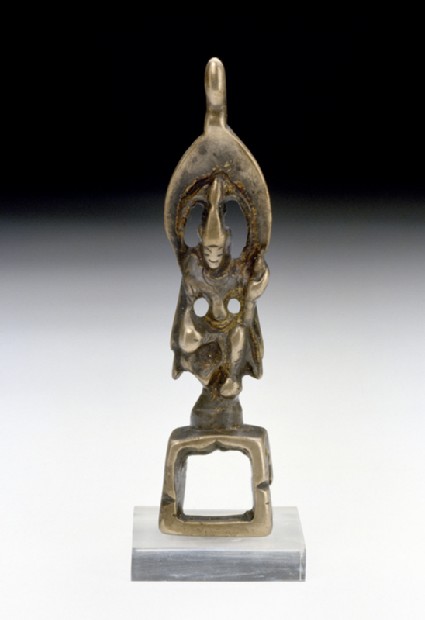Browse: 36 objects
- Reference URL
Actions
Seated figure of a bodhisattva
-
Details
- Associated place
- Date
- 6th - 8th century AD (AD 501 - 800)
- Material and technique
- bronze, solid cast
- Dimensions
- 8.9 x 2.1 x 1.7 cm max. (height x width x depth)
- Material index
-
processed material › metal › alloy › copper alloy › bronze
- Technique index
- Object type index
- No. of items
- 1
- Credit line
- Purchased, 1996.
- Accession no.
- EA1996.8
-
Further reading
Heller, Amy, Early Himalayan Art (Oxford: Ashmolean Museum, 2008), no. 22 on p. 86, illus. p. 87
Location
-
- currently in research collection
Objects are sometimes moved to a different location. Our object location data is usually updated on a monthly basis. Contact the Jameel Study Centre if you are planning to visit the museum to see a particular object on display, or would like to arrange an appointment to see an object in our reserve collections.
Publications online
-

Early Himalayan Art
This solid cast, male Bodhisattva is a very small figure, seated on a throne with draperies, surrounded by a pointed prabha. The right arm is raised, holding a small object which appears to be a vase; the left hand rests on the left knee. The figure is seated in lalitasana, with right leg pendant. He wears a crown with one central triangular panel extending to the prabha; two very small lateral triangular segments are visible just above his ear. Although no earrings are apparent, a necklace is indicated by incised carving. He wears an ankle-length dhoti of striped cloth whose pattern is indicated by incised diagonal lines. The back of the prabha is flat. The throne is placed on a small rounded pedestal which rests on a square open base. The base had four legs, one of which is now partly missing.
In his arm positions and lalitasana posture, this Bodhisattva recalls Chinese forms of Avalokitesvara popular during the Sui and Tang dynasties [1]. A very similar ex-voto is found in the collections of the Musee Cernuschi, Paris [2]. The vase may be carried by several different Bodhisattva figures, most frequently Maitreya or Avalokitesvara. In early ninth-century sculptures from eastern Tibet and in paintings made during the Tibetan occupation of Dunhuang, representations of Avalokitesvara may carry the vase, as part of the group of eight Bodhisattvas surrounding Vairocana; however these Bodhisattvas have gestures and iconographic attributes, corresponding to rituals then popular, which differ from later treatises [3]. Possibly this image was a member of a group; however, as it is now isolated, precise iconographic identification remains conjectural. The thin body and elongated proportions of this figure correspond closest to the small sculptures of Sui dynasty, although during the Tang, similar images were made in the Nan zhao kingdom (modern Yunnan), which was a close ally of Tibet in the late eighth century [4].
[Footnotes:]
1 See Rhie, 'Buddhist Images of Gansu', pl. 10, for a late Tang clay Bodhisattva in lalitasana; however the body is heavy and very different from that of the Ashmolean image.
2 Musee Cernuschi 6232: ex-voto of Avalokitesvara, Sui dynasty.
3 Whitfield, The Art of Central Asia in the Stein Collection of the British Museum, pl. 17; and Heller, 'Early Ninth-century Images of Vairocana from Eastern Tibet', for a standing Avalokitesvara holding a vase, dressed in long Tibetan robes.
4 Lutz, Der Tempel der Drei Pagoden von Dali, pl. 100, and p1. 101 for the Yunnan sculptures. I am grateful to Gilles Beguin of the Musee Cernuschi for his opinion that this sculpture may be identified as of Sui dynasty origin.
© 2013 University of Oxford - Ashmolean Museum

